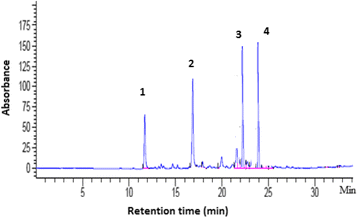Structural elucidation of some antimicrobial constituents from the leaf latex of Aloe trigonantha L.C. Leach
- PMID: 26264241
- PMCID: PMC4533789
- DOI: 10.1186/s12906-015-0803-4
Structural elucidation of some antimicrobial constituents from the leaf latex of Aloe trigonantha L.C. Leach
Abstract
Background: The incidents of drug resistant microorganisms and the need of treatments for newly emerging pathogens are of great concern to the global community. Our ability to treat infectious diseases is dependent on the development of new pharmaceuticals, and one potential source being medicinal plants with traditional claims. The leaves of Aloe trigonantha L.C. Leach, an endemic Ethiopian plant, are locally used for the treatment of infectious and inflammatory diseases. This study explores the potential of the latex of this plant and compounds isolated thereof for their in vitro antibacterial and antifungal properties.
Methods: Analytical RP-HPLC and silica gel preparative TLC were used for identification and isolation of active constituents, respectively. Characterization of the compounds was based on UV, IR, HR-ESIMS, (1)H and (13)C NMR, and 2D-NMR spectral assignments. Antimicrobial activity studies were carried out against 21 pathogenic bacterial and 4 fungal strains using the disk diffusion method. Minimum inhibitory concentrations (MICs) were determined by the broth dilution method.
Results: A C-glycosylated chromone identified as aloesin, and three C-glycosylated anthrones characterized as 8-O-methy-7-hydroxyaloin A/B, aloin A/B and aloin-6'-O-acetate A/B were isolated. The latex and isolated compounds exhibited in vitro antibacterial activity against the tested pathogens. In some cases the activity of the isolated compounds (MIC = 10 μg/mL) was comparable with that of the standard drug ciprofloxacin, particularly against some of the Gram-negative bacterial strains tested. However, their activity towards the fungal pathogens tested was relatively weaker showing maximum activity against Candida albicans with MIC value of 400 μg/mL.
Conclusion: The present findings can be used for further research aimed at the development of new antibacterial agents, and may also justify the ethnomedicinal claim of the plant for the treatment of infectious diseases.
Figures


Similar articles
-
A new antimicrobial anthrone from the leaf latex of Aloe trichosantha.Nat Prod Commun. 2014 Jul;9(7):949-52. Nat Prod Commun. 2014. PMID: 25230501
-
In vitro antimicrobial and antioxidant activities of anthrone and chromone from the latex of Aloe harlana Reynolds.Phytother Res. 2011 Dec;25(12):1756-60. doi: 10.1002/ptr.3482. Epub 2011 Mar 31. Phytother Res. 2011. PMID: 21452374
-
Antimalarial Activity of the Chemical Constituents of the Leaf Latex of Aloe pulcherrima Gilbert and Sebsebe.Molecules. 2016 Oct 28;21(11):1415. doi: 10.3390/molecules21111415. Molecules. 2016. PMID: 27801850 Free PMC article.
-
Antimicrobial properties of the medicinal plant Cardiospermum halicacabum L: new evidence and future perspectives.Eur Rev Med Pharmacol Sci. 2019 Aug;23(16):7135-7143. doi: 10.26355/eurrev_201908_18759. Eur Rev Med Pharmacol Sci. 2019. PMID: 31486516 Review.
-
Antifungal Proteins from Plant Latex.Curr Protein Pept Sci. 2020;21(5):497-506. doi: 10.2174/1389203720666191119101756. Curr Protein Pept Sci. 2020. PMID: 31746293 Review.
Cited by
-
Ethnobotany and the Role of Plant Natural Products in Antibiotic Drug Discovery.Chem Rev. 2021 Mar 24;121(6):3495-3560. doi: 10.1021/acs.chemrev.0c00922. Epub 2020 Nov 9. Chem Rev. 2021. PMID: 33164487 Free PMC article. Review.
-
Pharmacological Activities and Characterization of Phenolic and Flavonoid Compounds in Solenostemma argel Extract.Molecules. 2022 Nov 22;27(23):8118. doi: 10.3390/molecules27238118. Molecules. 2022. PMID: 36500211 Free PMC article.
-
Aloin remodels the cell wall of Candida albicans to reduce its hyphal virulence against oral candidiasis.Appl Microbiol Biotechnol. 2025 Jan 24;109(1):21. doi: 10.1007/s00253-025-13411-7. Appl Microbiol Biotechnol. 2025. PMID: 39853490 Free PMC article.
-
Pharmacological Activities and Characterization of Phenolic and Flavonoid Compounds in Methanolic Extract of Euphorbia cuneata Vahl Aerial Parts.Molecules. 2021 Dec 3;26(23):7345. doi: 10.3390/molecules26237345. Molecules. 2021. PMID: 34885927 Free PMC article.
-
Antihyperglycemic Activity of TLC Isolates from the Leaves of Aloe megalacantha Baker in Streptozotocin-Induced Diabetic Mice.Diabetes Metab Syndr Obes. 2021 Mar 15;14:1153-1166. doi: 10.2147/DMSO.S288313. eCollection 2021. Diabetes Metab Syndr Obes. 2021. PMID: 33758524 Free PMC article.
References
-
- Khalil A, Dababneh BF, Al-Gabbiesh AH. Antimicrobial activity against pathogenic microorganisms by extracts from herbal Jordanian plants. J Food Agric Env. 2009;7:103–106.
-
- Silva NC, Fernandes JA. Biological properties of medicinal plants: a review of their antimicrobial activity. J Venom Anim Toxins. 2010;16:402–413. doi: 10.1590/S1678-91992010000300006. - DOI
-
- WHO: Antimicrobial Resistance: Global Report on Surveillance. Geneva; Switherland. 2014.
-
- Mahesh B, Satish S. Antimicrobial activity of some important medicinal plants against plant and human pathogens. World J Agric Sci. 2008;4:839–843.
MeSH terms
Substances
LinkOut - more resources
Full Text Sources
Other Literature Sources
Medical

